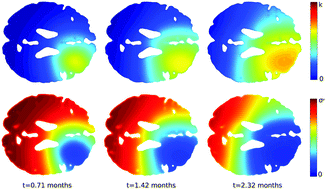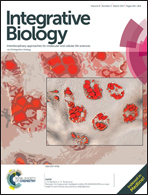Quantitative analysis of the proliferative-to-invasive transition of hypoxic glioma cells
Abstract
Hypoxia is a hallmark of gliomas that is often associated with poor prognosis and resistance to therapies. Insufficient oxygen supply reduces the proliferation rate of tumor cells, which contributes to a slower progression of the lesion, but also increases the invasiveness of the tumor, making it more aggressive. To understand how these two counteracting mechanisms combine and modify the tumor's global growth, this paper proposes a quantitative approach based on a biomathematical model. The model predicts that the net effect of the proliferative-to-invasive transition leads to a lower survival even for slight increments of the invasive capacity of hypoxic tumor cells. The model also shows that tumor cells use the phenotype change to normalize the levels of oxygen in the tissue. The model results can be directly compared to in vivo data obtained using anatomic and molecular imaging modalities.



 Please wait while we load your content...
Please wait while we load your content...